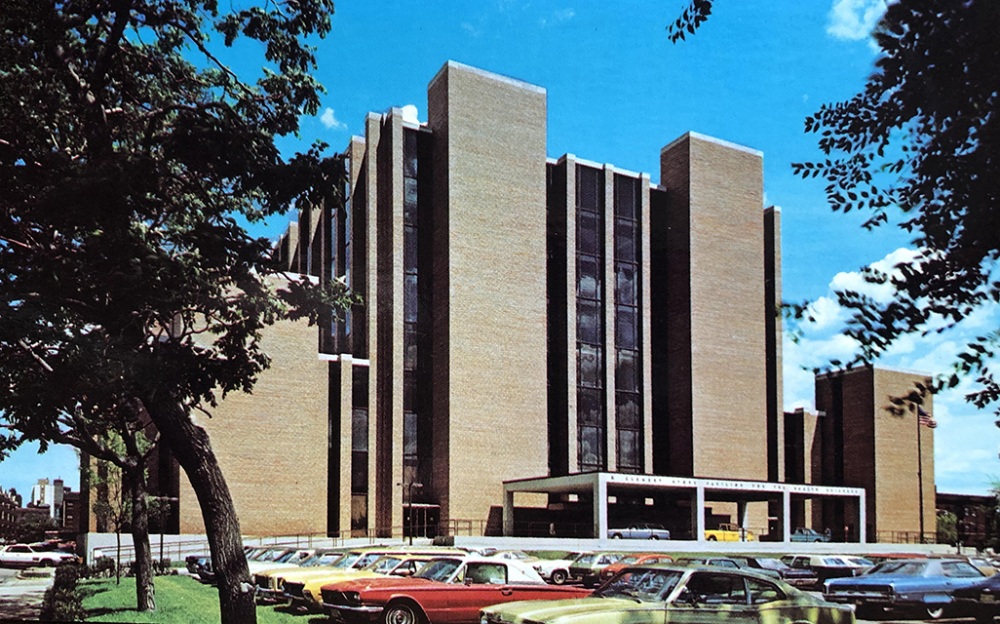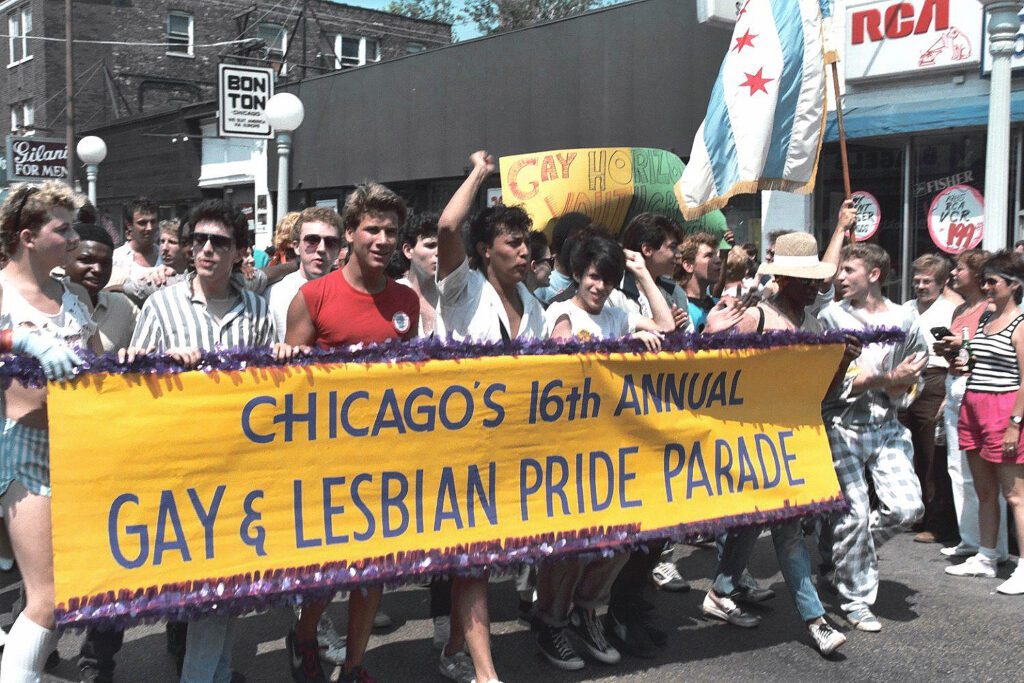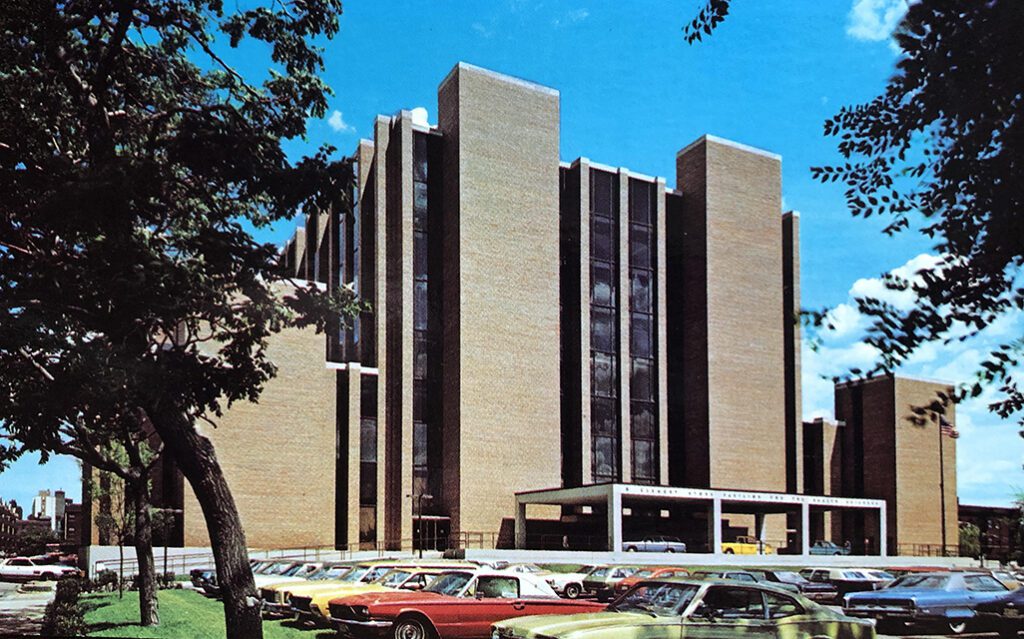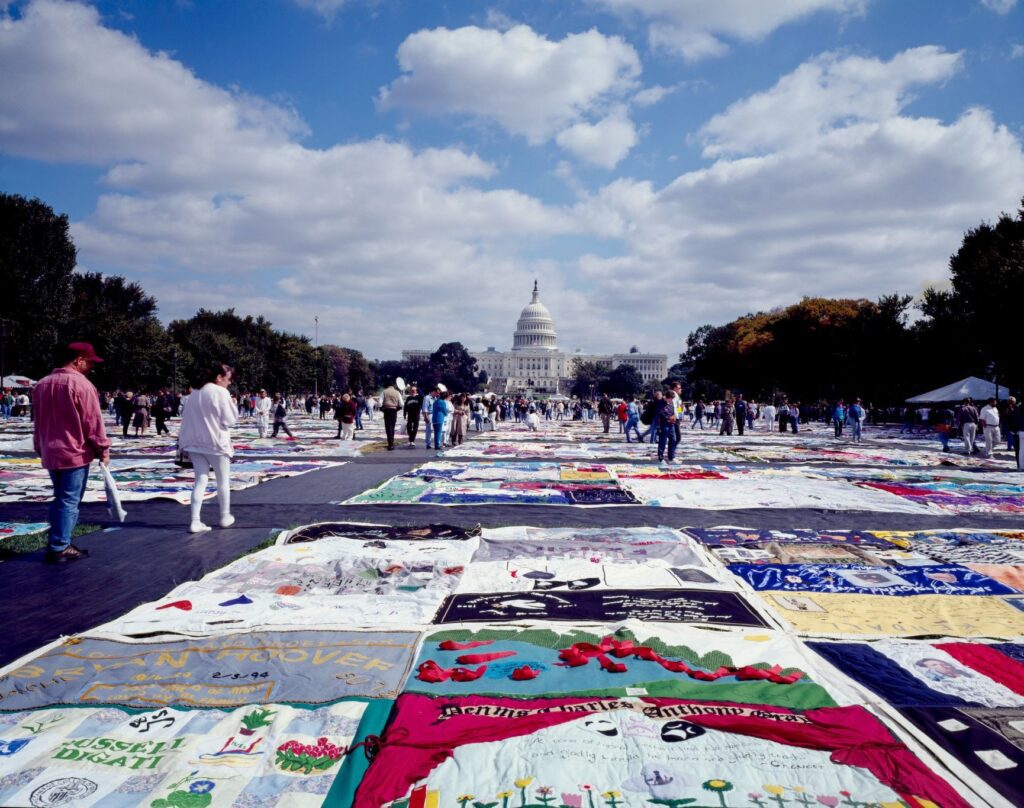

AIDS Care Unit 371 opened at Illinois Masonic Medical Center in Chicago in 1985. It was the first inpatient care unit dedicated to HIV/AIDS in the Midwest.[1] Unit 371 is also important because of its compassionate approach to patient care. Because of fear and stigma surrounding the disease, AIDS patients were often treated like social outcasts. By providing a sense of safety, community, and belonging for patients, Unit 371’s staff demonstrated the importance of compassion in a time of crisis.
Historical Context: HIV/AIDS in Chicago
At the start of the 1980s, medical professionals noticed rising rates of strange illnesses among gay men. These illnesses included pneumonia and purple lesions called Kaposi’s sarcoma. In 1981, newspaper reports primarily focused on the east and west coasts, but the disease began to spread throughout the United States, including in Chicago.[2]
In January 1982, this group of unusual illnesses became known as gay-related immune disorder (GRID). By July, the Centers for Disease Control and Prevention (CDC) renamed the disease acquired immunodeficiency syndrome (AIDS).[3] It took two more years until researchers identified human immunodeficiency virus (HIV) as the cause of AIDS. They also discovered that HIV was transmitted through exposure to certain bodily fluids.
HIV effectively eliminates the body’s immune system. The virus targets and destroys T-cells, which defend against pathogens and disease. But before HIV destroys a T-Cell, it uses the cell to make copies of itself, so the HIV can spread and destroy all the T-cells throughout the body.[4]
This leaves the body vulnerable to all kinds of infections, ranging from the common cold to cancer. Without the body’s natural defenses, the onset of these infections in one or multiple parts of the body can be deadly.[5]
Although reports initially indicated that HIV/AIDS primarily affected gay men, the virus was not confined to that group. As a new disease, everyone was vulnerable. But it hit some groups harder at first than others. Transgender people, injection drug users, sex workers, and other marginalized people faced increased risk of contracting HIV. Since people of color already experienced racial discrimination and socioeconomic inequality, they faced extra levels of vulnerability.[6]
To make matters worse, the federal government was slow and unwilling to respond to the epidemic. President Reagan did not publicly acknowledge AIDS until September 1985. Despite the rising death rate, federal inaction delayed the distribution of vital resources for HIV/AIDS awareness and research.

In the city of Chicago, thousands of people were diagnosed with HIV. Some died within days or weeks of being diagnosed, while others lived with the disease and died years later. According to the Illinois Department of Public Health, the year 1995 saw the highest number of AIDS-related deaths in Chicago: 1,030.[7]
There was a lot of fear associated with HIV/AIDS because very little was known about it.[8] Until 1984, neither doctors nor the public knew how it was transmitted, so some people—including caregivers—were afraid to touch or be around people who were diagnosed. The stigma was so severe that some people were shunned from their families and lost their jobs or homes.[9] As the AIDS crisis worsened, the LGBTQ+ community also experienced an increase in harassment and violence.[10]
Origin of Unit 371
Dr. David Blatt and Dr. David Moore founded Unit 371 at Illinois Masonic Medical Center in 1985.[11] Known as “the two Davids,” the pair met while doing their residencies at Chicago’s Cook County Hospital. They became medical and life partners.
When AIDS emerged, it shook the community hard. At the time, the Davids worked at Howard Brown Memorial Clinic, where they and other gay health providers were already offering care for sexually transmitted diseases.[12]
Moore was inspired to create Unit 371 while visiting Unit 5A at San Francisco General Hospital. Unit 5A “clustered” AIDS patients in one unit. He and Blatt were exhausting themselves educating individual units at Illinois Masonic Medical Center about care for AIDS patients while also providing for their other patients.
Due to the social and emotional impacts of HIV/AIDS, many patients also required interpersonal support and assistance beyond medical care that would usually be fulfilled by family members.[13] To manage these needs, it made sense to consolidate caregivers’ medical expertise and resources with patients in one unit.
But the Davids still worried that Unit 371 would share the stigma associated with AIDS. Dedicating the entire unit to HIV/AIDS care meant that staff was informed about the challenging nature of their work from the start. Instead of deterring support, this motivated some LGBTQ+ people to care for their own community. Several of Unit 371’s staff members identified as gay or lesbian themselves.[14]
Within the Illinois Masonic Medical Center, Unit 371 became the preferred unit for HIV-positive patients who did not need to be admitted to the intensive care unit. It started as an inpatient unit with 23 beds. Nine of the rooms were originally dedicated to hospice, but as the AIDS crisis worsened and the number of patients swelled, this system was insufficient and abandoned. Many of the single rooms were converted to accommodate two patients. Staff reserved private rooms for patients who were dying or could pass on an infection.[15]
Compassionate Community Care
Illinois Masonic Medical Center was not the only hospital providing AIDS care in Chicago. These services were also offered at St. Joseph’s Hospital, Rush Medical Center, and Cook County Hospital. But Unit 371 was different.
HIV/AIDs had no cure. Unit 371 staff knew that patients would face long, difficult illnesses. For this reason, the staff wanted to make the patients and their loved ones as comfortable as possible.[16]
Unlike other units, Unit 371 displayed patients’ art on the walls. The unit had its own art therapy program which provided patients the chance to process their emotions creatively. As part of the program, they could draw, paint, play music, and socialize.[17]
Because patients faced so much disdain outside the unit, staff fostered community and connection within it. Unit 371 had lounges where both staff and families could listen to music or watch television. Staff also encouraged patients and families to bring food for the unit’s open kitchen. Many patients lost their appetites, and staff hoped that familiar food with friends and family would encourage patients to eat.
Food played an important role in bringing people together in Unit 371. For almost 15 years, three local restaurants donated food on designated days of the week. The restaurants provided meals for patients, staff, and visitors without charging the unit.[18]

But what really set Unit 371 apart were the personal relationships between staff and patients. Although nursing and medical training typically discouraged intimacy, it was common for Unit 371 staff to sit on patients’ beds, offer hugs, joke around, or become friends and socialize outside of the unit. This closeness was especially meaningful for patients who were rejected by family and friends after being diagnosed.[19]
These relationships were also important for staff. About half of the unit consisted of intensive care and the other half was dedicated to hospice. The environment was intense and crisis-ridden.[20]
Because patients could suffer from many kinds of infections, AIDS manifested in a lot of different ways. This made it challenging for medical staff to manage the dozens of medications and treatments associated with individual patients.[21] Despite the rigors of the job, staff remembered the importance of their vulnerability, sense of community, and culture of providing comfort.
Staffing for the unit consisted of designated physicians, nurses, social service workers, a chaplain, and volunteers. These individuals were specifically trained to provide for the needs of the patients, using the model of compassionate care that the unit fostered. To serve the psychosocial needs of both staff and patients, Unit 371 also had its own psychiatric liaison.[22]
Through this holistic, relationship-centered approach, the unit modeled a new kind of community care. Some former patients also returned as volunteers to give back after receiving help themselves. Others started volunteering after learning about how some families abandoned patients. While these blurred boundaries were necessary to meet patients’ needs, they could be challenging to emotionally process.[23] The loss of a patient often also meant the loss of a friend.
Hope on the Horizon
Hundreds of people died at Unit 371. But by the mid-1990s, hope was on the horizon. The introduction of protease inhibitors in 1995 and the availability of highly active antiretroviral therapy (HAART) in 1996 changed the treatment of AIDS.
HAART was a combination of drugs that reduced the amount of HIV in the body. This meant two things: the level of HIV in a person’s system would not register in standard blood tests; and that there was not enough virus in the person’s system to be sexually transmitted to someone else. Although HAART did not cure HIV, it turned AIDS from a fatal illness into one that was chronic, yet manageable.[24]

When HAART was first introduced, Unit 371 staff were hesitant to offer it, since they lacked a full understanding of how the treatment worked. This ran counter to their training in nursing and medical school. But patients were willing to take the risks, especially after the years of devastation that AIDS had inflicted on the gay community.[25]
Beginning in 1987, doctors had used the anti-viral drug, azidothymidine (AZT), to treat patients who were HIV-positive. But AZT had its own side effects and only slowed but did not stop the progression of the virus. It was also expensive, costing each patient $8,000 per year (about $19,500 in 2022 dollars).[26]
HAART made a big difference and helped many patients to get stronger and recover. It didn’t work for everyone, though. Some patients continued to get worse. Others were already too sick to withstand the new treatment.[27] But overall, the number of patients in Unit 371 began to decrease beginning in 1998.
With decreased demand, operations in Unit 371 shifted. All double rooms became single rooms, and nurses moved to other units within Illinois Masonic Medical Center, or took jobs elsewhere. When Unit 371 officially closed in 2000, medical staff began to send HIV-positive patients to the cancer unit.[28]
In her graphic memoir and history of Unit 371, former nurse MK Czerwiec emphasizes the safety and dignity that patients and staff felt there. Despite all the loss, there was also life and love. She explains, “The biggest thing that emerges from Unit 371, the AIDS crisis, for me…is that there are no days to be wasted. There’s not a life later. It’s now, this is all we get.”[29]
There is still no cure for HIV/AIDs. In 2019, the CDC estimated that there were 1.2 million people living with HIV in the United States.[30] According to the Joint United Nations Programme on HIV/AIDS, an estimated 37.7 million people were living with HIV around the world in 2020.[31] Although HIV is a lifelong diagnosis, access to antiretroviral therapy and other treatments make it possible to live with the disease and prevent its transmission.
Notes
[1] MK Czerwiec, Taking Turns: Stories from HIV/AIDS Care Unit 371, Graphic Medicine (University Park, Pennsylvania: The Pennsylvania State University Press, 2017), 208.
[2] Tracy Baim, “AIDS: The Plague Years,” Out and Proud in Chicago: An Overview of the City’s Gay Community, edited by Tracy Baim (Evanston, IL: Surrey Books, 2008), 145.
[3] Czerwiec, Taking Turns, 28; Baim, “AIDS: The Plague Years,” 148.
[4] Czerwiec, Taking Turns, 6.
[5] Czerwiec, Taking Turns, 9.
[6] Timothy Stewart-Winter, “A New Disease Is Not Welcome Here,” Queer Clout: Chicago and the Rise of Gay Politics (Philadelphia: University of Pennsylvania Press, 2016), 206.
[7] Baim, “AIDS: The Plague Years,” 150; Czerwiec, Taking Turns, 64.
[8] Czerwiec, Taking Turns, 28; Baim, “AIDS: The Plague Years,” 148.
[9] Baim, “AIDS: The Plague Years,” 152.
[10] James Coates, “AIDS Backlash Gets Violent, Gays Say,” Chicago Tribune, October 26, 1986, ProQuest Historical Newspapers: Chicago Tribune; Jean Griffin, “Reports of Gay Harassment Soaring,” Chicago Tribune, May 11, 1987, ProQuest Historical Newspapers: Chicago Tribune.
[11] Czerwiec, Taking Turns, 25; Baim, “AIDS: The Plague Years,” 152.
[12] Baim, “AIDS: The Plague Years,” 148.
[13] Czerwiec, Taking Turns, 28.
[14] Czerwiec, Taking Turns, 29-30.
[15] Czerwiec, Taking Turns, 208.
[16] Czerwiec, Taking Turns, 19.
[17] Czerwiec, Taking Turns, 50.
[18] Czerwiec, Taking Turns, 209. Food was delivered to Unit 371 from Pete’s Pizza, El Jardin, and Ann Sather. All three restaurants are still open.
[19] Czerwiec, Taking Turns, 23.
[20] Czerwiec, Taking Turns, 35.
[21] Czerwiec, Taking Turns, 36.
[22] Czerwiec, Taking Turns, 140, 208.
[23] Czerwiec, Taking Turns, 67, 150; Terry Wilson, “Stepping Up: Volunteers Help Patients Who Have HIV, AIDS to Cope,” Chicago Tribune, January 22, 1995, ProQuest Historical Newspapers: Chicago Tribune.
[24] Czerwiec, Taking Turns, 147-148.
[25] Czerwiec, Taking Turns, 147.
[26] Czerwiec, Taking Turns, 215; Rebecca Makkai, “They Were Warriors,” Chicago Magazine, April 7, 2020, https://www.chicagomag.com/Chicago-Magazine/May-2020/Oral-History-ACT-UP-Chicago-AIDS/.
[27] Czerwiec, Taking Turns, 148-149.
[28] Czerwiec, Taking Turns, 150, 164, 208.
[29] Czerwiec, Taking Turns, 176.
[30] Centers for Disease Control and Prevention. “Estimated HIV Incidence and Prevalence in the United States, 2015–2019.” HIV Surveillance Supplemental Report 26, no. 1 (May 2021). https://www.cdc.gov/hiv/pdf/library/reports/surveillance/cdc-hiv-surveillance-supplemental-report-vol-26-1.pdf
[31] UNAIDS. “Global HIV & AIDS Statistics—Fact Sheet.” Resources. Last updated July 2021. https://www.unaids.org/en/resources/fact-sheet.
Bibliography
Baim, Tracy, ed. Out and Proud in Chicago: An Overview of the City’s Gay Community. Evanston, IL: Surrey Books, 2008.
Borcherts, Julia. “AIDS: Margaret Bausch: HIV/AIDS Nurse Reflects on a Life of Caring.” Windy City Times. January 4, 2012. https://www.windycitytimes.com/m/APPredirect.php?AID=35491.
Coates, James. “AIDS Backlash Gets Violent, Gays Say.” Chicago Tribune. October 26, 1986. ProQuest Historical Newspapers: Chicago Tribune.
Czerwiec, MK. Taking Turns: Stories from HIV/AIDS Care Unit 371. Graphic Medicine. University Park, Pennsylvania: The Pennsylvania State University Press, 2017.
Griffin, Jean. “Reports of Gay Harassment Soaring.” Chicago Tribune. May 11, 1987. ProQuest Historical Newspapers: Chicago Tribune.
Jackson, Bechetta. “Aids Activists Shift Focus as Quilt Comes to Chicago.” Chicago Tribune. November 27, 1998. https://www.chicagotribune.com/news/ct-xpm-1998-11-27-9811270194-story.html.
Makkai, Rebecca. “They Were Warriors.” Chicago Magazine. April 7, 2020. https://www.chicagomag.com/Chicago-Magazine/May-2020/Oral-History-ACT-UP-Chicago-AIDS/.
Stewart-Winter, Timothy. Queer Clout: Chicago and the Rise of Gay Politics. Philadelphia: University of Pennsylvania Press, 2016.
Wilson, Terry. “Stepping Up: Volunteers Help Patients Who Have HIV, AIDS to Cope.” Chicago Tribune. January 22, 1995. ProQuest Historical Newspapers: Chicago Tribune.
About the Author
Jade Ryerson (she/her) is a master’s student in the Heritage Studies and Public History program at the University of Minnesota, Twin Cities. She has written extensively about the places where BIPOC, LGBTQ+, and working-class women made history for the National Park Service Cultural Resources Office of Interpretation and Education. You can find more of her work on the blogs of the National Council on Public History, the American Conservation Experience, and DePaul University Special Collections and Archives.
Keywords
LGBTQ+; Health; Illinois; Pride

America’s Field Trip Awardees!
Thousands of students from across the country submitted inspiring entries, responding to the prompt “What does America mean to you?” for the first-ever America’s Field Trip contest. A panel of current and former educators selected 150 students as awardees, hailing from 44 states and territories.